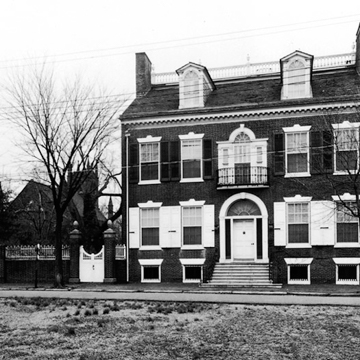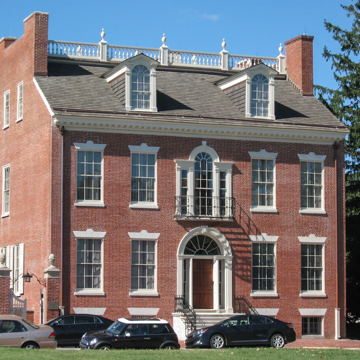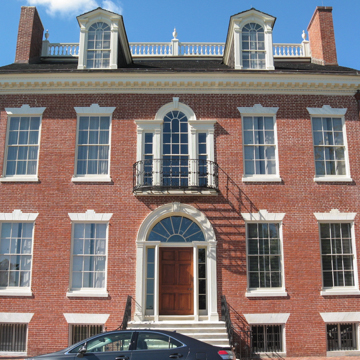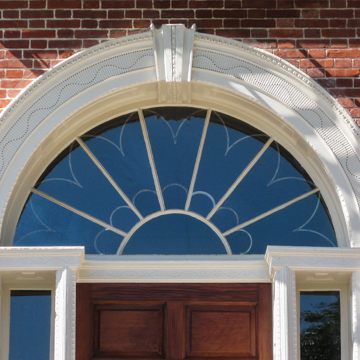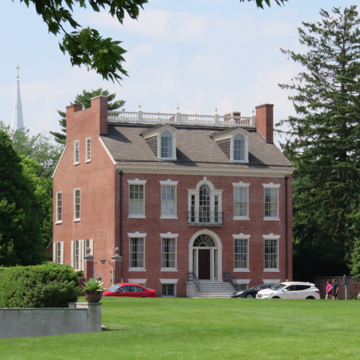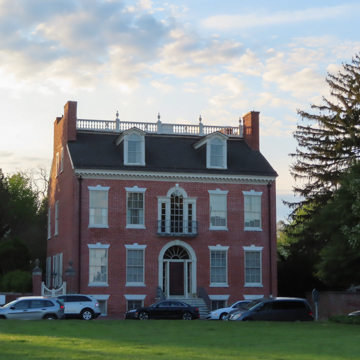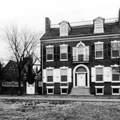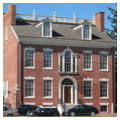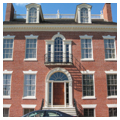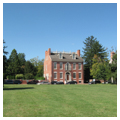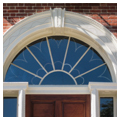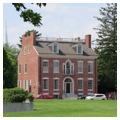Delaware's best-known historic house is a masterpiece of the Federal style. The lawyer George Read grew up in the home of his father (a signer of the Declaration of Independence), which was located where the garden now stands; it burned in the fire of 1824. Young Read spent considerable time in Philadelphia and intended to imitate the town houses of that city. Construction of this house is extensively documented in his papers, in which four plans survive. He built a wharf to receive foundation stone from Chester, Pennsylvania, as well as bricks transported from Philadelphia by shallop boats at a dollar per thousand. Carpenter Peter Crouding of Philadelphia was hired, and he visited sawmills to price lumber, choosing a supplier near Dagsboro, Sussex County. Drawings made by Crouding in December 1797 show decorative window heads for the facade, “one with stone kee [key] and brick arch the other all Stone”; Read requested instead the same pattern as on his brother-in-law's house at 260 Arch Street, Philadelphia. These window heads were executed in marble in that city, stored for a year during which Read indecisively halted work, then finally delivered in June 1799. A shipment of 250,000 bricks came from Philadelphia in 1801, and Wilmington bricklayer Thomas Spikeman was engaged, the bricks to be laid “in the best manners according to the mode fashion and Stile of working & finishing the front Walls of the best Buildings in the City of Philadelphia.” Stylistic similarities to that city were profound—for example, in the Palladian window centered above the fanlit front door, an arrangement found at Philadelphia's William Bingham Mansion (c. 1786, burned 1823).
After the exterior was finished, decoration of the interior commenced. Benjamin Henry Latrobe offered to furnish patterns for the cornices, though apparently he never did so, and later he privately faulted Read's “enormous house, in bad taste … close by the water, of which to enjoy a scanty view he sacrifices a range of the most valuable lots in town, by not building upon them, and he has then planted a range of Lombardy poplars which exclude the prospect as effectually as a brick wall.” Crouding found mahogany for the doors, for which Read was eager. Composition ornament for chimneypieces was supplied by Philadelphian Robert Wellford in 1803. Subjects include “the triumph of Mars returning from Battle” and “ Diana giving command to her hounds.”
By constantly wetting the roof, the house was saved from the Strand fire of 1824, and subsequently it passed through the generations virtually unchanged. When an owner died in 1919, a Wilmington newspaper warned, “It would be a grave crime to let the old house fall into inappreciative ownership. To think of its being gutted of its treasures makes one shudder.” Indeed, large sums were offered for the woodwork and the old boxwood shrubbery. Fortunately, investment banker Philip Laird and his wife, Lydia, bought the place and undertook a sensitive renovation (1920, Brown and Whiteside) and added the brick garden wall. New steps and railings followed the design of architect E. William Martin. The house was ivy-covered in 1925 when architect Kenneth Clark made measured drawings for White Pine. During this decade it attracted widespread attention in magazines as an ideal type of American residence. Wallpaper installed in the dining room (1927, Chapman Decorative Company, Philadelphia) showed scenes of New Castle history and architecture, including the Court House, George Read I House, and William Penn's landing in 1682.
Today, the Read House is a museum operated by the Historical Society of Delaware, its owner since 1975, when Lydia Laird died. Restorers mistakenly removed shutters from the exterior on the basis of there being none on the Latrobe-Mills survey (which omits shutters as a matter of course). In an ambitious campaign inside (1981–1986, Martin Rosenblum), spaces were refurnished according to the inventory of 1836, “the Goods & Chattels of George Read deceased,” which organizes items by room (front and back parlors, entry, store room, kitchen, cellar, rooms upstairs, garret, nursery, library, yard, wash house, stable) and lists everything from mahogany chairs to oyster knives.


